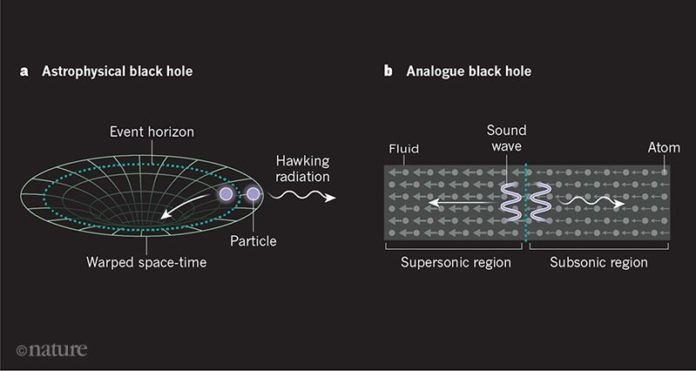The entropy of a black hole and Hawking radiation should have the same temperature given by the surface gravity, within a numerical factor of the order of unity. In addition, Hawking radiation should have a thermal spectrum, which creates an information paradox. However, the thermality should be limited by greybody factors, at the very least. It has been proposed that the physics of Hawking radiation could be verified in an analogue system, an idea that has been carefully studied and developed theoretically.
However, classical white-hole analogues have been investigated experimentally. Now, for the first time, scientists observed spontaneous Hawking radiation in an analogue black hole.
In a new study, scientists have verified the scientist’s namesake theory, Hawking Radiation, which hypothesized that black holes emit radiation from their surfaces due to a mix of different factors regarding quantum physics and gravity.
To verify the theory, scientists at the Technion-Israel Institute of Technology turned to what sounds like mad science: creating their own black hole. What’s more, they have measured the temperature of a lab-made sonic black hole, which traps sound instead of light.
This black hole isn’t like the black holes out in space, where gravity creates a region of spacetime so warped that light can’t escape. Instead, the researchers built a black hole analogue using a strange quantum material called a Bose-Einstein condensate, in which the point of no return is for sound rather than light. Still, it’s an important verification of Hawking’s work.
The scientists created an elongated Bose-Einstein condensate by trapping 8,000 rubidium atoms in a focused laser beam. Bose-Einstein condensates are systems of ultra-cold atoms where strange quantum physical phenomena become more visible on larger scales. They are often used for analogue-type experiments like these.
A second laser increases the potential energy on one side of the Bose-Einstein condensate, making it denser on that side. A sharp transition separates the denser area (considered to be outside the black hole) and the less dense area (inside the black hole). This transition moves at a constant speed through the condensate, but from the point of view of the experimenters, it appears to be stationary; instead, it looks as if all of the rubidium atoms are moving.
Outside the black hole in the denser region, the speed of sound is faster than the speed of this flow, so sound waves can move in either direction. But in the less dense region—inside the black hole—the speed of sound is slower, so sound waves only travel away from the sharp transition and further into the black hole.
Hawking radiation comes from pairs of quantum particles that constantly pop up everywhere, even in empty space. Normally, those particles immediately annihilate one another. But at a black hole’s edge, if one particle falls in, the other could escape, resulting in Hawking radiation. In the sonic black hole, a similar situation occurs: Pairs of sound waves known as phonons can appear, with one falling in and the other escaping.
Measurements of the phonons that escaped and those that fell in allowed the scientists to estimate the temperature, 0.35 billionths of a kelvin.
Physicist Ulf Leonhardt of the Weizmann Institute of Science in Rehovot, Israel, who was not involved with the study said, “It’s a very important milestone. It’s new in the entire field. Nobody has done such an experiment before.”
The experiment also reveals one interesting feature of the black hole- outside the black hole, light can either move away from or into the black hole. But once inside the black hole, it cannot escape.
During the experiment, the analogue replaces the light with sound, and the researchers can measure sound waves both outside and inside their black hole. The signal of the Hawking radiation is a correlation between these two kinds of waves.
Scientists constructed this analogue black hole with improvements compared with their previous set up such as reduced magnetic field noise, enhanced mechanical and thermal stability and redesigned optics. They found that the correlation spectrum of Hawking radiation agrees well with a thermal spectrum, and its temperature is given by the surface gravity, confirming the predictions of Hawking’s theory.
Jeff Steinhauer of the Technion-Israel Institute of Technology in Haifa said, “The way I see it, what we saw was that Hawking’s calculations were correct. The Hawking radiation observed is in the regime of linear dispersion, in analogy with a real black hole, and the radiation inside the black hole is composed of negative-energy partner modes only, as predicted.”
Mathematician Silke Weinfurtner at the University of Nottingham in the United Kingdom wrote in a Nature commentary that “the research was “promising” and that the scheme the researchers used to extract the temperature of the radiation was “clever.” Perhaps, the setup will be useful in measuring other interesting quantum phenomenon expected to occur near the black hole’s event horizon.”
The study is published in the journal Nature.
